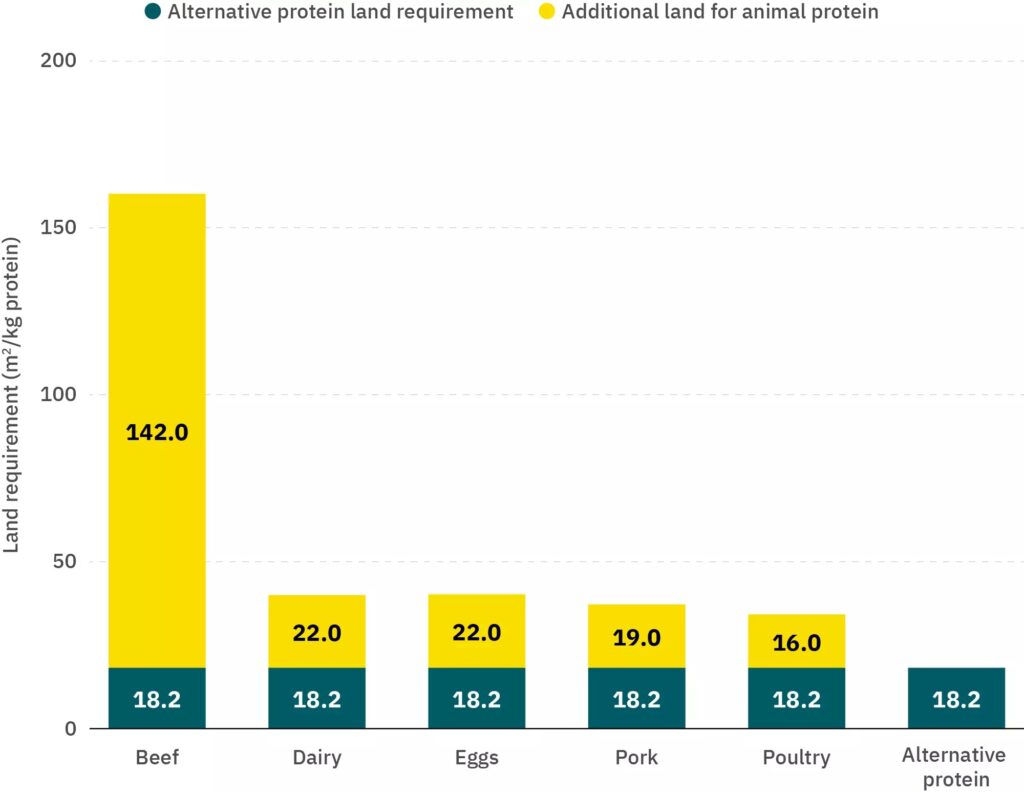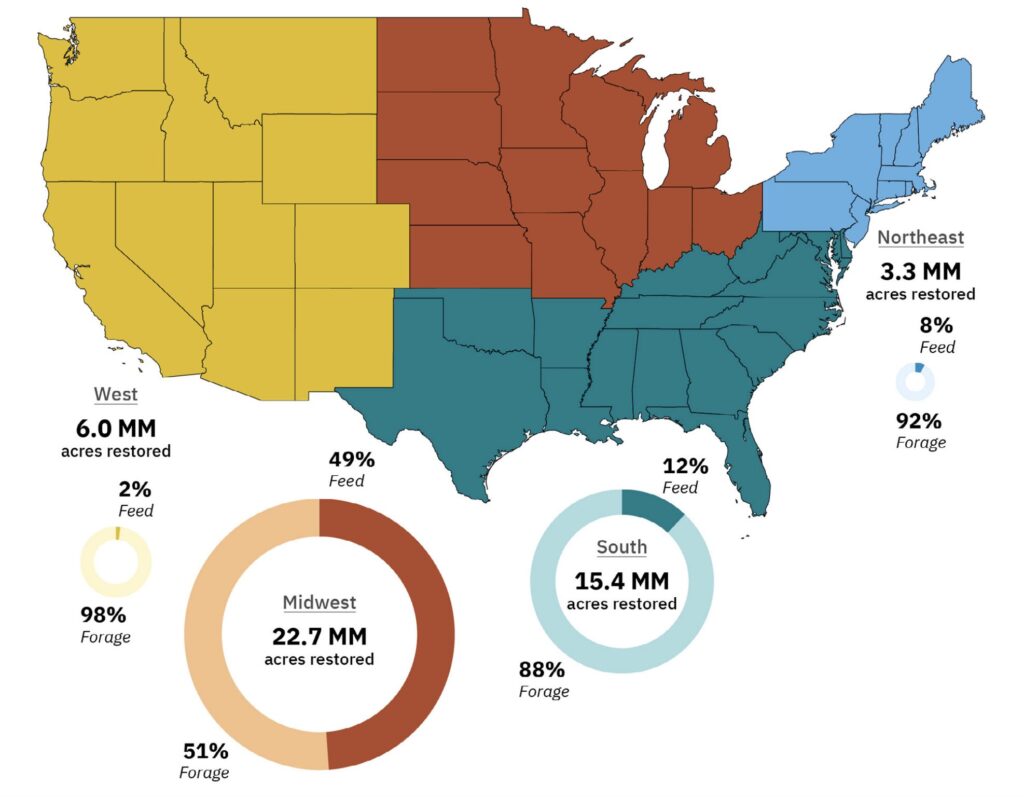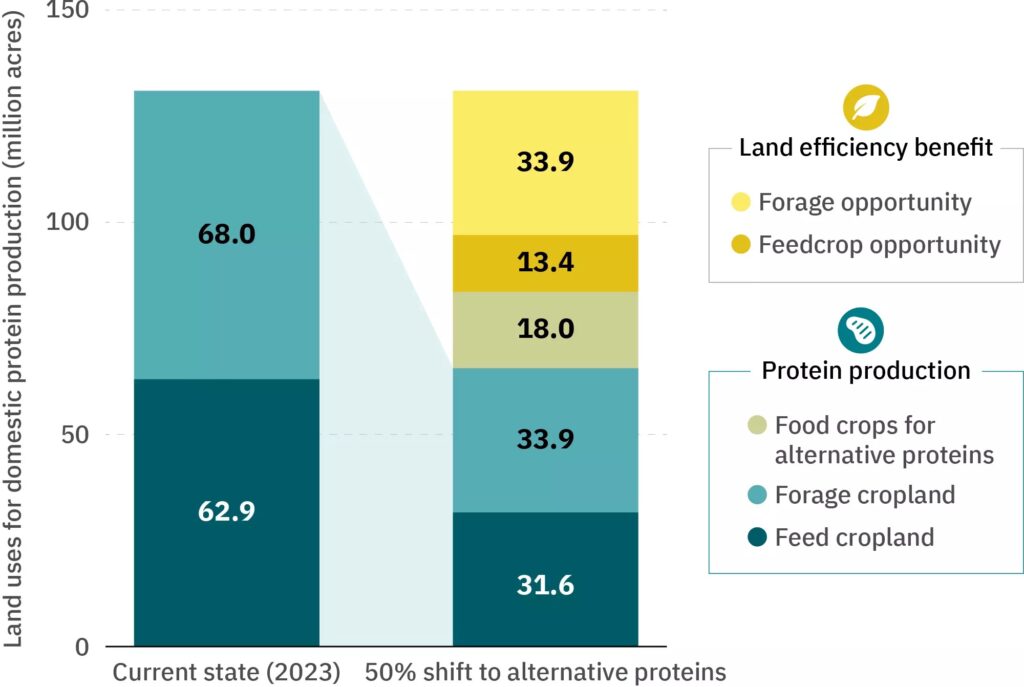Switching Half the US Protein Supply to Alternative Proteins Can Free Up Land the Size of South Dakota
5 Mins Read
A 50% shift to alternative proteins in the US would make land use much more efficient, alongside biodiversity and carbon sequestration gains for the Midwest and South.
If Americans switch half their meat, dairy and egg intake to alternative proteins, the country would see land nearly the size of South Dakota be freed up. What’s more – the Midwest and South regions can become better carbon sinks, while restoring many threatened ecosystems.
That’s the consensus of a new report exploring the land use benefits of alternative proteins. Authored by the Good Food Institute (GFI) and Highland Economics, Transforming Land Use focuses on US cropland demand to meet current protein consumption, and quantifies how the US can get closer to its biodiversity and climate goals by focusing on proteins that require much less land than animals.
In the US, 42% of land is used for grazing livestock. And of the 21% that is cropland, more than three-quarters is dedicated to crops primarily supporting livestock production. Meanwhile, alternative proteins require 50-90% less land on average than animal proteins per protein – and yes, that includes poultry and eggs too.

But if the US substituted 50% of animal products for alternative proteins, the report finds that 47.3 million acres of cropland would no longer be needed to produce food. Americans collectively eat eight billion kgs of animal protein per year, so cutting that in half would eliminate the need for 32 million acres of forage and 31.5 million acres of feed crops.
However, the report doesn’t include the land restoration benefits linked with rangelands (where the native vegetation is grass) for grazing livestock, using cropland for biofuels or animal feed exports, water use, and other environmental impacts like greenhouse gas emissions. This means that these benefits – purely for land use – are conservative estimates of the true prospects of alternative protein.
How alternative proteins can change America’s landscape
Freeing up all this land would enable the large-scale restoration of the US’s threatened ecosystems. Of the 485 ecosystems in the country, 45% are currently vulnerable or endangered.
The researchers identified the ecosystems present before the land was converted into feed crops and forage cropland, and can survive in the future with restoration. The proposed shift to alternative proteins was found to have the potential to restore 64% of these threatened ecosystems.
Since the South and the Midwest are home to a significant percentage of feed crops and forage cropland in the US, they have a high number of threatened ecosystems. The Midwest would have the opportunity to restore 84% of its feed crop area (higher than anywhere else in the US), while the South has the greatest opportunities for ecosystem restoration

The US National Climate Task Force has set a goal of conserving 30% of national land and waters by 2030, and shifting to 50% alternative proteins alone would help restore 13% of the area in this target.
Meanwhile, the restored natural area available from the protein transition would sequester 178 million tonnes of CO2e annually – that’s more than the combined emissions of all domestic flights in the US in 2021. This would mean a 22% increase in the average net national carbon sink associated with land use and forestry. Here, too, the South and Midwest present the greatest carbon sequestration opportunities, at 48% and 33%, respectively.
US government must increase policy support for smart proteins
On a global level, agriculture, forestry and other land uses account for up to 24% of all emissions. Livestock and feed production, meanwhile, have made up 65% of global agricultural land use change in the last 50 years, according to separate research, which said dietary shifts towards more animal-sourced and ultra-processed foods are putting a major strain on land, with factory farming and forest clearance closely associated with animal agriculture.
Climate scientists have suggested that land use alone represents a quarter of the world’s emissions mitigation potential between now and 2050.
And research by Our World in Data has found that beef, sheep, goat and buffalo meats have the greatest carbon opportunity costs per kg – which refers to the land that could be used to restore native vegetation and sequester carbon if a foodstuff wasn’t being grown on it.

The GFI report makes several recommendations for NGOs and governments to enable a transition to alternative proteins. Non-profits should push governments to back R&D and commercialisation efforts for smart proteins; analyse the socioeconomic impacts of a shift to these foods, and advocate for policies that add revenue streams for farmers; as well as expand land use efficiency benefits across borders.
As for policymakers, they must increase investment into alternative protein research to enhance their taste, texture, price, nutrition, and production capabilities. Governments are urged to promote the scaling up of biomanufacturing, new equitable workforce opportunities, and regional diversity. Additionally, public policies that support farmers and boost new markets for locally produced alternative protein crops are crucial.
“To reach [the US’s] ambitious 2030 and 2050 targets for climate change mitigation and land conservation and restoration, diversifying our protein supply is essential,” the report reads. “More policy support will be necessary to create appealing alternative protein products, scale their production, and provide them at an affordable price to the public.”



